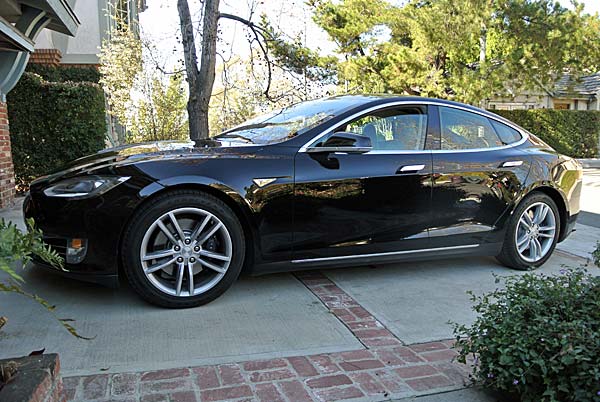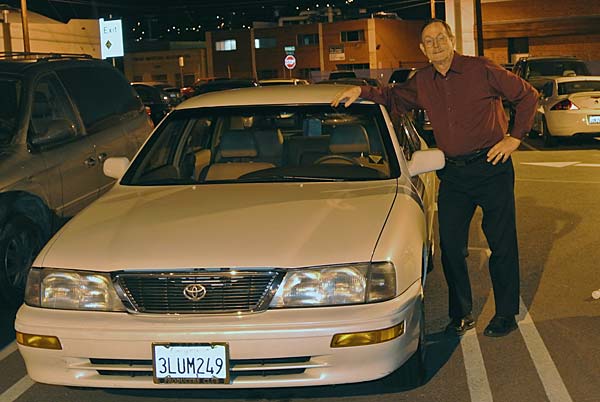 Monday
night, 14 January, we got the call that our car was ready and when did we
want to pick it up? - we had previously decided to pick up the car at the
Fremont, CA factory rather than have it delivered to our home, because the
time lag could be 10 days to 2 weeks. We left for the airport very early
Thursday morning in our family car - a 1995 Toyota Avalon - that was bought
new by Craig's dad and inherited by Craig upon his father's passing in 2004.
This car was in Weightman care for its entire life and had served us well..
We found a home for it and Mario, its new owner, would pick it up at the
airport after we flew out.
Monday
night, 14 January, we got the call that our car was ready and when did we
want to pick it up? - we had previously decided to pick up the car at the
Fremont, CA factory rather than have it delivered to our home, because the
time lag could be 10 days to 2 weeks. We left for the airport very early
Thursday morning in our family car - a 1995 Toyota Avalon - that was bought
new by Craig's dad and inherited by Craig upon his father's passing in 2004.
This car was in Weightman care for its entire life and had served us well..
We found a home for it and Mario, its new owner, would pick it up at the
airport after we flew out.
Our new car was totally electric - that's absolutely silent - for the combustion engine people out there. Craig had first ordered it in 2009, three years before they started production.
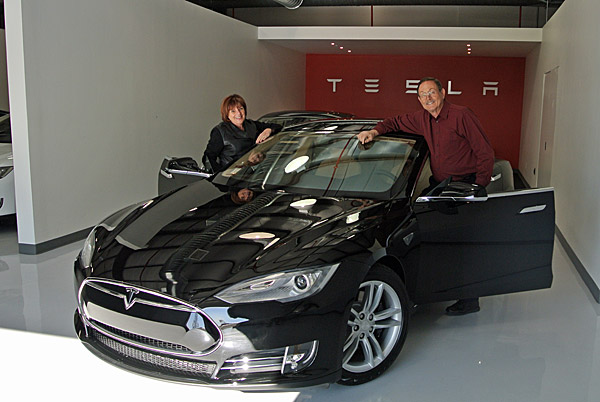
Patty and Craig had decided to fly to San Jose, take a tour of the factory, and then drive the car home that day. We were probably among a very few customers who would decide to take a car directly off the factory floor and immediately take it on a 400mi drive. What could go wrong?
We first took a tour of the factory, but no cameras were allowed. This is the old GM/Toyota factory and Tesla is taking up less than 25% of the total space. It is quite a change from the old-time production lines Patty's dad took her through at the GM plant in Van Nuys, CA when she was young.
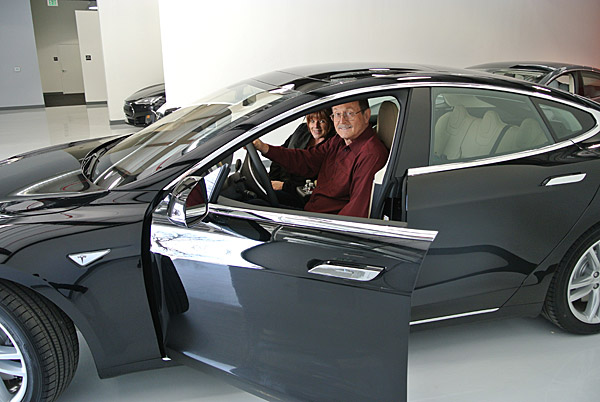
One of the things we weren't supposed to see was a special build of a Model S that was, we were told, to have two engines and be a Tesla performance car, hopefully setting speed records. It was fun seeing how that special car - accompanied by an army of workers - was integrated into the standard production line. It is obvious why no cameras are allowed on the factory floor. They wouldn't even let us near the part of the assembly line that installed the batteries in our car.
When we were done we simply got into our car and drove it out the standard door, made a right turn in the parking lot and proceeded out the Main Gate to the 880 freeway. We thought we were now on our own and would be home in 6 hours or less - the bliss of the innocent.
We proceeded south, through San Jose, to Gilroy, CA and turned to go over Pacheco Pass, then down US route 5. In this mountain pass we got to try out the car's sports car attributes and it held the road like nothing Craig had ever driven before. We won't talk about speed here, but let's just say we sometimes got way, way over the limit - however it was brief, due to the possibility of a ticket.
Our electric car has a range of about 200 miles, then we need to
recharge it. At home we have a 240v outlet that we would be recharging
the car with, but on the road we relied on supercharger stations Tesla
installed at various points in the U.S. These stations are available
for Tesla owners having the medium or large battery sizes and
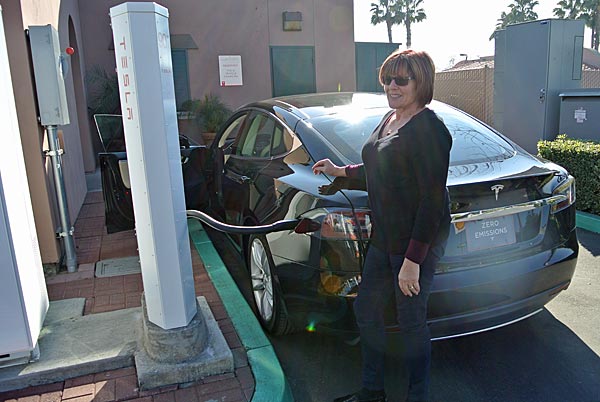 Tesla
anticipates 100 of these stations will be available throughout the U.S.
by 2015. They allow owners to take long car trips because fully charging
a depleted battery should only take just over an hour - substantially
less than a home charge. Since, for us, this means we have to stop every
3.5-4 hours we find it convenient to use this time to snack or eat.
Our first stop would be a Harris Ranch Shell station, just about 160
miles from the factory.
Tesla
anticipates 100 of these stations will be available throughout the U.S.
by 2015. They allow owners to take long car trips because fully charging
a depleted battery should only take just over an hour - substantially
less than a home charge. Since, for us, this means we have to stop every
3.5-4 hours we find it convenient to use this time to snack or eat.
Our first stop would be a Harris Ranch Shell station, just about 160
miles from the factory.
Here we see Patty at the charging station.
Our car didn't charge in the allotted hour - it didn't charge in two hours - our car didn't show any charge at all. We had only a six mile range left and couldn't go anywhere! Houston, we have a problem.
The 800 number listed on the charging station wasn't in operation - what kind of company is this anyway? We found out later that the factory had a complete power failure - the entire factory - after we left. I guess we just have that kind of effect on others. In desperation we called one of the Tesla dealers - the car is basically a computer and we could easily access the internet through it. They contacted a support group for us and Tesla then contacted us back and worked with us through this ordeal.
The factory can track all their cars 24/7 and had us try different things - telling us the car was acting properly, but no amps were being transmitted.
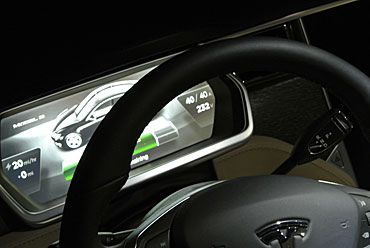 Tesla
finally identified a 240v outlet - like ours at home - and we used it
to charge the car, but much more slowly. In the end it was six hours;
much of that time was trying different things after the first two hours,
but we left with enough energy to get to the next supercharger station.
Another Tesla used the station without incident while we were there
so the charger was apparently ok, but our thought that this would be
a simple trip didn't exactly work out as planned. Everything at the
second station worked like a charm and we had enough energy in 20 minutes
to carry us all the way home.
Tesla
finally identified a 240v outlet - like ours at home - and we used it
to charge the car, but much more slowly. In the end it was six hours;
much of that time was trying different things after the first two hours,
but we left with enough energy to get to the next supercharger station.
Another Tesla used the station without incident while we were there
so the charger was apparently ok, but our thought that this would be
a simple trip didn't exactly work out as planned. Everything at the
second station worked like a charm and we had enough energy in 20 minutes
to carry us all the way home.
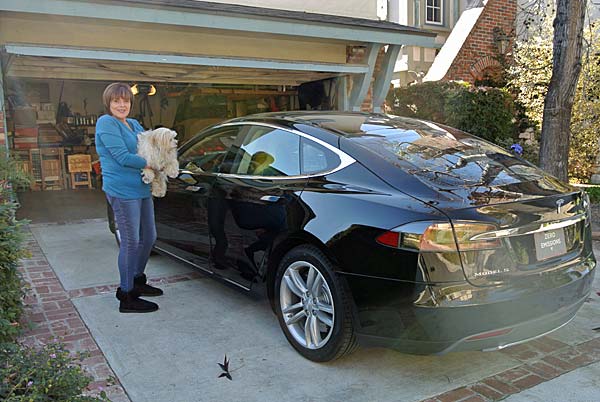
Note: We finally understand the amp the problem. We have since had to 'jiggle' the connection several times before amps started to charge - see the 40/40 in the above picture. Tesla will be looking at the connection to see if there is any production problem here. It had as much to do with being the first time we tried to charge the car as anything. Of course we almost fully discharged the battery on our very first drive - not the normal customer.
Acceleration in this car is instantaneous and smooth - when you step on it you simply fly past another car - more like a jet than a gas car. The Model S has a long wheelbase and is 6" wider than our Toyotas, so it rides smooth and corners without any lean. This is a sports car in a luxury car body.
These pictures show the car in our driveway the next morning. Of course Patty had to introduce KiKi to his new car.

The 'cockpit', where you control pretty much everything, is contained within a 17" computer screen - no, there are no knobs on this. Everything is pretty intuitive and we certainly learned a lot more about all the functions in one day with our car than do most owners. We were walked through practically everything at one time or another by Tesla people trying to figure out exactly why our car wouldn't charge. It was a bit weird to have someone on the other end of the phone tell you exactly what your car was doing while you were sitting in it, but we weren't stranded alone on the highway.
Here is a picture of the Tesla interior screen in L.A. traffic, showing the rear facing camera - we use it to view our blind spots - and a map of the Los Angeles area. You can select from a number of different viewing options and switch everything around at will - a rather different, and personal, way of organizing your car interior.
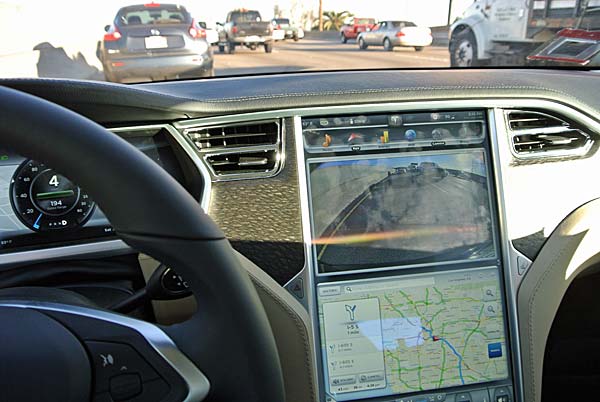
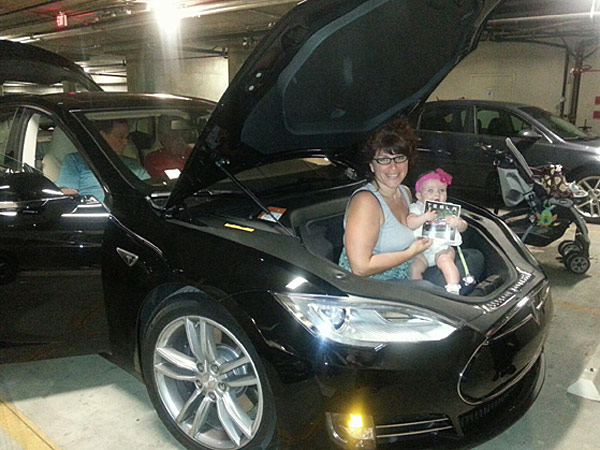
Finally, the family got to see the Tesla and our daughter Danielle found it was a great place to babysit her niece Ashley.

